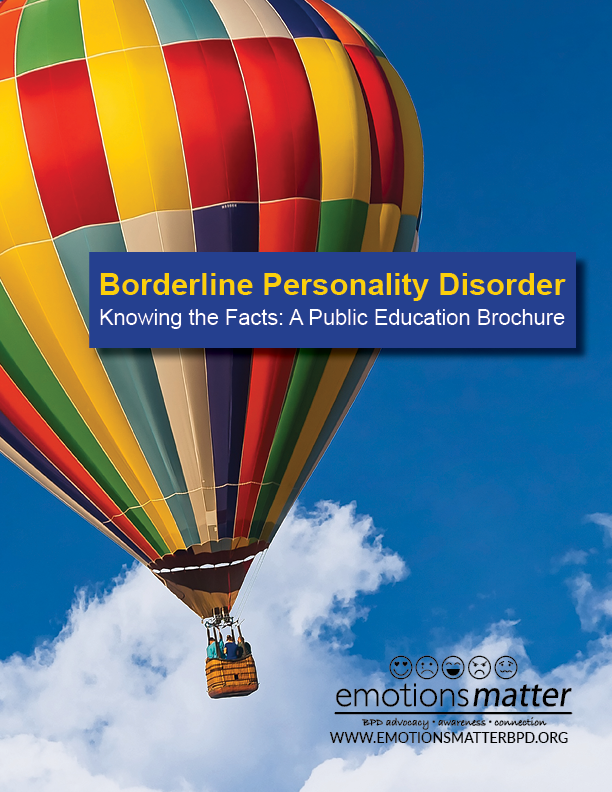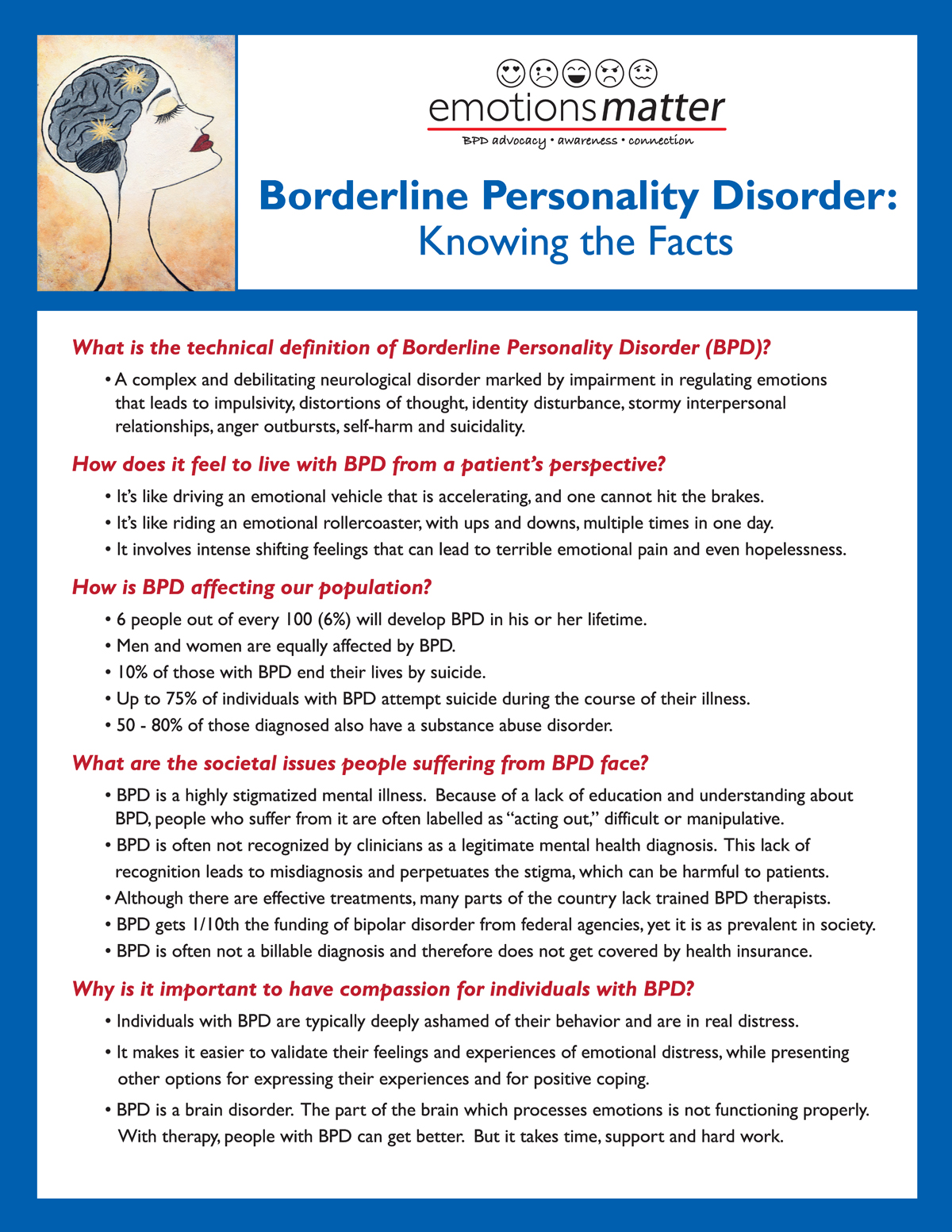Emotions Matter Video: Spreading Awareness
Watch our first video, written and directed by Saleena Subaiya, MD, and produced by Anna Yeager. In this video two women with BPD share their stories and take to the streets of New York City to spread awareness about the disorder.
WHAT IS BORDERLINE PERSONALITY DISORDER(BPD)
A complex condition characterized by extreme difficulty regulating emotions, distress, and confusion about their sense of self, unstable relationships, and impulsive behaviors.
Individuals are diagnosed with BPD if they meet five or more of the following criteria, as listed by the American Psychiatric Association’s Diagnostic and Statistical Manual of Mental Disorders (DSM):
Frantic efforts to avoid real or imagined abandonment
Unstable, intense relationships where individuals alternate between idolizing and disliking individuals in their life
An unstable self-image or sense of self
Impulsivity in at least two areas that can be damaging
Recurrent suicidal behavior, gestures, threats, or self-harm
Affective instability (irritability, anxiety, etc.) that can last a few hours, but rarely more than a few days
Chronic feelings of emptiness
Intense anger or difficulty controlling anger
Stress-related paranoia or severe dissociative (out-of-body) symptoms
The DSM also introduced a new way of describing BPD and other personality disorders that mentions difficulties with identity, self-direction, empathy, and intimacy as main concerns.
Impact of BPD on Daily Living, Work & School
A diagnosis of BPD can cause an individual to experience difficulty in some of the following areas related to work or school:
● Maintaining regular attendance, including arriving on time
● Taking tests or undergoing performance evaluations
● Transitioning between tasks, especially if there are multiple ongoing tasks
● Managing expectations and feedback from teachers or supervisors
● Advocating for or accessing resources
● Communicating with peers, coworkers, teachers, or supervisors
● Structuring time and forming or sticking to a schedule
● Organizing important materials
● Managing the expectations of employment
● Forming a healthy relationship with social media
● Regularly completing self-care, such as grooming and bathing
These are just some of the ways that BPD can influence the functional aspects of a person’s life. Fortunately, there are many accommodations and resources available to help individuals with BPD manage the effects of this condition and continue to live their life happily and productively.
Causes of BPD
Biology (BPD & a Person’s Brain)
Individuals who have BPD experience different processes in certain areas of their brains, including:
● The emotion-processing center (also known as the amygdala), which causes individuals to experience emotions more deeply and intensely than others do.
● The prefrontal cortex, which regulates emotions and is less active in those with BPD.
● An over-responsive fight or flight response, causing individuals to remain in “go” mode where their emotions go from zero to sixty within a few seconds and return to a “resting” mode much more slowly than other individuals once this response is triggered.
Research also shows that there may be a genetic risk for developing BPD. The good news is that treatment can tremendously help with these reactions. Just as medications are recommended to help certain symptoms, therapies for BPD help retrain the brain to produce more balanced responses.
Psychology (BPD & a Person’s Thoughts)
Individuals with BPD may have different thought processes, including:
● An increased chance of negatively interpreting social and emotional cues (communication, facial expressions, etc.)
● Difficulty understanding other peoples’ emotions and tending to assume their thoughts and motives
This can cause individuals difficulty communicating, developing a firm sense of identity, managing their mood, and forming relationships.
Environment (BPD & a Person’s Surroundings)
Research shows that individuals who experience invalidating environments (and also have the biological and psychological risk factors listed above) are at an increased risk for developing BPD. An invalidating environment is any situation that does not offer adequate emotional support and nurturing. Some examples of invalidating environments are:
● Child maltreatment
● Hostility from parents or children when growing up
● Disorganized attachments with others
● Traumatic situations
● Emotional abuse
Aspects of the Disorder
SYMPTOMS OF BPD EXPLAINED
Chronic Emptiness
Individuals with BPD often report that they feel there is a hole or a void that never goes away. This feeling of emptiness also often contributes to a poor self-image, since it can prevent people from developing confidence and positive self-esteem. It is not uncommon for this emptiness to trigger impulsivity in individuals with BPD, causing them to engage in reckless behaviors to provide a stimulus and rid themselves of the empty feeling. Unfortunately, these behaviors do not fix the emptiness, which may cause individuals to develop a dependence on drugs, alcohol, or other dangerous behaviors in an attempt to numb this feeling.
Unstable Relationships
Because of the intense emotions, frequent mood changes, and tendency to interpret others’ actions toward them as negative, individuals with BPD often have unstable, short-lived relationships or ongoing relations marked by conflict. This often presents as:
● Falling in love quickly (also called infatuation or idealization)
● Believing that another person can be perfect, will make you whole, and will eliminate feelings of emptiness
● Black-and-white thinking (either loving or despising the other person in response to the last thing they did)
● Frequent feelings of anger with significant other
● Alternating between extremes of overinvolvement with and withdrawal from other people
Memory Impairment
Memory changes associated with BPD often stem from affected areas in the brain that control emotions, learning, and memory. Due to the intense emotions that people with BPD experience, they are far more likely to remember content associated with these emotional states. This negative (or even traumatic) emotional content is more likely to be stored in the brain long-term. However, this means other memories (often those that are positive or neutral) may not be stored as easily. These memory impairments may present as:
● Frequently feeling persecuted due to misjudging or misremembering the actions of others
● Difficulty seeing the positive in certain people or situations
● Vivid, disturbing memories of traumatic experiences
● Trouble remembering responsibilities or tasks at work, school, or home
Fear of Abandonment
Individuals with BPD often have an intense fear of abandonment and rejection. For many individuals, this fear surrounds the loss of relationships or friendships and perceiving negative criticism from loved ones, supervisors, or teachers, even when it may not be there. But others may experience an intense fear of events they view as a form of abandonment, such as being apart from those they love for even short periods of time. This causes many individuals to behave frantically or erratically to avoid experiencing any type of abandonment or rejection.
● Preoccupation with real and perceived abandonment
● Repeated attempts to contact someone
● Continually begging someone not to leave them
● Hiding or withholding possessions
● Blocking or clinging to another person to prevent them from leaving
Distorted Self-Image
This symptom may be difficult for some people to understand. When put simply, individuals with BPD often do not have a firm, consistent view of themselves. They often lack a clear sense of purpose and direction in their lives. This results in low confidence and an inability to identify or understand what makes them special and unique.
This may appear as:
● Excessive self-criticism
● Difficulty talking about how they feel and how others feel
● Trouble recognizing when to sympathize or apologize to others
● Struggling to remember their own positive qualities (often leading to view themselves as evil or worthless with inconsistent self-esteem)
● Difficulty setting goals and committing to a consistent vision for their life
Impulsivity
This is a hallmark feature of BPD that may cause individuals to engage in some of the following dangerous behaviors:
● Reckless driving
● Gambling
● Excessive spending
● Self-injury (cutting, skin picking, burning, etc.)
● Misuse of drugs and alcohol
● Unsafe sex
● Binge-eating
While suicidality may underlie self-injury in some instances, many people misinterpret all self-injury or drug use as suicide attempts. However, they can also be attempts to numb the emotional pain that individuals with BPD experience.
Non-suicidal Self-Injury
While self-injury can be an act of impulsivity, this behavior can also be planned, deliberate, or habitual in nature. This is called non-suicidal self-injury. The root cause of this varies, and can stem from emotional dysregulation, the need to punish oneself, or feelings of abandonment or rejection. Non-suicidal self-injury can include behaviors such as:
● Burning
● Cutting
● Skin-picking or skin-carving
● Scratching
● Punching or hitting
● Biting
● Pinching
● Bone-breaking
When individuals describe episodes of self-injury, many say that they do not realize they have done this until the episode is over. The emotional pain is so tremendous that their mind shuts down until it is completely distracted by physical pain.
Rapid, Intense Mood Swings
Individuals with BPD may report or experience some of the following emotions:
● Boredom
● Anxiety
● Worry
● Depression
● Anger
● Sadness
● Hostility
While these mood swings are intense, they typically last a few hours or days. This sets BPD apart from other forms of mental illness such as bipolar disorder and major depressive disorder, which have longer periods of unstable mood. Moreover, the mood swings in BPD do not include prolonged periods of elevated mood (known as hypomania or mania) since they are usually the result of interpersonal triggers, such as feeling criticized or rejected.
Stress-Related Paranoia & Dissociation
Feelings of anxiety and anger toward others can stem from (or cause) paranoia. Individuals with BPD may question others’ motives, a behavior that often worsens with stress and can even result in out-of-body feelings or dissociation. While dissociation can develop from an individual’s paranoia, this symptom can also occur on its own. Individuals who are increasingly paranoid may experience:
● Difficulty concentrating
● A lack of connection with reality
● Frequent conflicts, arguments within relationships
● Social isolation
● The feeling of being watched or followed
● Suspicions of other peoples’ motives and intentions
● Difficulty working with others at work or school
Why is BPD a serious condition?
● Individuals with BPD experience intense feelings of self-hatred, anger, depression, or anxiety. These feelings are often scary, overwhelming and difficult to control. In the midst of intense emotions, individuals with BPD can act impulsively to alleviate emotional pain, self-soothe, or communicate emotional distress.
● Sadly, up to 10% of individuals with BPD lose their lives to suicide.
● 80% of those hospitalized with BPD have engaged in self-harm, including behaviors such as self-cutting, burning of the skin, self-hitting, self-biting, head banging, scratching, skin carving, and needle sticking. The emotional pain they are experiencing feels so intolerable that self-harm is a way of coping to relieve their intense psychic pain.
● Sometimes, people accidentally inflict more harm upon themselves than they intended.
● These concerns should be responded to with extreme compassion, on par with any other serious medical disorder. Friends, family, clinicians, and community members can help by validating their experience of emotional distress, providing a safe environment, and help them to access the appropriate level of treatment and support needed for recovery.
Myths vs. Facts
Many people feel that someone with BPD is somehow responsible for it, but this is far from the truth. Stigma surrounding this condition involves false beliefs such as “BPD comes from moral weakness” or “individuals with BPD do not respond to treatment.” These myths must be disproven and replaced with the facts of the condition to increase awareness and improve treatment efforts.
BPD can’t be diagnosed in adolescence or childhood
Signs of BPD are typically visible in adolescence and even early childhood. Seeking care from a BPD specialist is important to receiving an early diagnosis.
All BPD patients have been abused
A history of abuse or trauma may lead to BPD, but genetics and other factors play a role.
Individuals with BPD are untreatable or treatment resistant
There are many effective BPD treatments available that, when combined with social support and validating environments, can tremendously help individuals with BPD.
Medications are effective
While there are no known medications that treat BPD as a whole, medications can manage BPD symptoms such as anxiety and depression. Psychotherapy is considered the primary treatment for BPD; medications are adjunctive.
People with BPD are manipulative
Individuals with BPD often attempt to numb the intense emotional pain that they experience, which may lead them to display some extreme behaviors.
It is impossible to live a full life with BPD
Research shows that with proper treatment and support, over 90% of individuals with BPD are able to manage their symptoms!
How are people living with BPD affected by this condition?
Individuals may experience feelings such as…
● Driving a vehicle that is accelerating and the brakes aren’t working
● Riding an emotional rollercoaster with ups and downs multiple times in one day
● Constant shame, worthlessness, and self-loathing without an identifiable trigger
● Going through life like a raw nerve
How are loved ones and caretakers affected by BPD?
Research has shown that loved ones of those with BPD experience significant…
● Grief
● Burden
● Loss of empowerment
● Depression
● Anxiety
How is BPD affecting our population?
● Between 1.5 and 6% of people will develop BPD in their lifetime
● Men and women are equally affected, but more women are seen in treatment settings
● 10% of individuals with BPD complete suicide
● 50-80% of individuals with BPD struggle with substance use disorder
What are the biggest societal issues people suffering from BPD face?
● Stigma that BPD is not a valid illness and that those suffering are “acting out” and manipulative
● Lack of recognition that this is a real disorder, causing many individuals to remain undiagnosed or to be misdiagnosed with bipolar disorder, treatment-resistant depression, or PTSD
● Scarcity of therapists who are qualified to provide effective treatments
● BPD gets 10% of the National Institute of Mental Health (NIMH) funding that bipolar disorder receives, yet is at least as prevalent
● Some insurance companies have not accepted BPD as a billable diagnosis even though this practice goes against the mental health parity laws
Treatment
First and foremost, medication is rarely the only treatment for BPD. This means that the most effective care for individuals with BPD is a personalized mix of psychotherapies (explained below) and medication to manage symptoms.
Treatment for BPD should also place a special emphasis on family support. This not only addresses environments (some of which may be traumatic or invalidating), but also ensures that family members are educated on how to best help their loved one.
Dialectical Behavior TherapY (DBT) focuses on these key areas:
● Balancing change and acceptance
● Weighing opposing viewpoints to resolve contradictions
● Skills training
● Mindfulness
● Distress tolerance
● Interpersonal effectiveness
● Emotion regulation
Format: Training groups, individual therapy, and phone coaching
Mentalization-Based Therapy (MBT) focuses on these key areas:
● Distinguishing between your own thoughts and the thoughts of others
● Understanding others’ thoughts, feelings, and desires
● Mentalization, or reflection on outside situations
Format: Twice weekly sessions alternating between individual and group therapy
Transference-Focused Psychotherapy (TFP) focuses on these key areas:
● Developing accurate internal views and images of oneself and others
● Practicing these views through the patient-therapist relationship
● Resolving internal conflict about contradictory feelings (loving feelings and angry feelings) as they interfere with the person’s stable sense of self and stable relationships with others.
Format: Twice weekly individual sessions
General/Good Psychiatric Management (GPM) focuses on these key areas:
● Creating a “containing environment” where people can learn to trust and feel
● Case management
● Building a life outside of therapy
● Psychoeducation
● Coping strategies for BPD
● Family-based interventions
● Medications, as an adjunctive treatment
Format: Flexible. Usually includes once weekly individual sessions and may also include family sessions.
Schema Therapy focuses on these key areas:
● Examining unhealthy thought patterns and behaviors
● Strengthening healthy coping skills
Format: Individual sessions
Recovery & BPD
BPD is unlike other mental health conditions in that there is a wide spectrum of symptoms that individuals may experience. While this may make it difficult for individuals to find the treatment they need, they can learn the skills to manage their symptoms and live a full life. Recovery is possible with the help of community resources and treatment methods to cope with the effects of BPD.
References
Bailey, R.C. (2013). Burden and support needs of carers of persons with borderline personality disorder: A systematic review. Harvard Review of Psychiatry, 21, 248-258.
Ball, S.A., et al. (1997). Personality, temperament, and character dimensions and
the DSM-IVpersonality disorders in substance abusers. Journal of Abnormal Psychology, 106, 545-553.
Bender, R. (2016). Non-Suicidal Self Injury. Perelman School of Medicine,
University of Pennsylvania; Department of Psychiatry.
Cacciola, J.S., et al. (2001). Psychiatric comorbidity in patients with substance use
disorders: Do not forget Axis II disorders. Psychiatry Annals, 31, 321-331.
Goodman, M. et al. (2012). Suicidal risk and management in borderline personality
disorder. Current Psychiatry Reports, 14, 79-85.
Grant, B.F., et al. (2008). Prevalence, correlates, disability, comorbidity of DSM-IV
borderline personality disorder: Results from the wave 2 National Epidemiologic Survey on Alcohol and Related Conditions. Journal of Clinical Psychiatry, 69, 533-545.
Marco, J.H., et al. (2015). Meaning in life in people with borderline personality
disorder. Clinical Psychology and Psychotherapy, 24(1), 162-170. doi:10.1002/cpp.1991.
National Institute of Mental Health. (2016).
http://www.nimh.nih.gov/health/statistics/prevalence/bipolar-disorder- among-adults.shtml
Trull T.J., et al. Borderline personality disorder and substance use disorders: A
review and integration. Clinical Psychology Review, 20(2), 235-253.
Zimmerman, M. (2015). Borderline personality disorder: A disorder in search of
advocacy. Journal of Nervous and Mental Disease, 203, 8-12.
(Revised 9.9.20)















